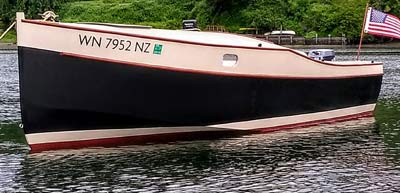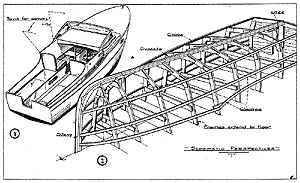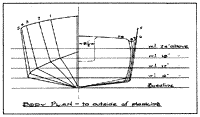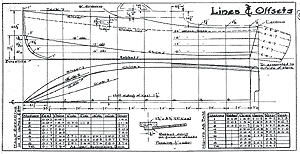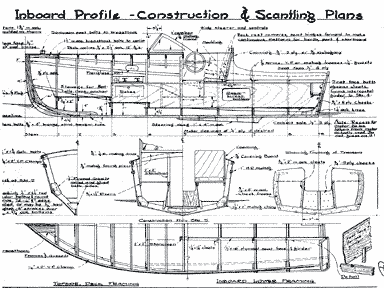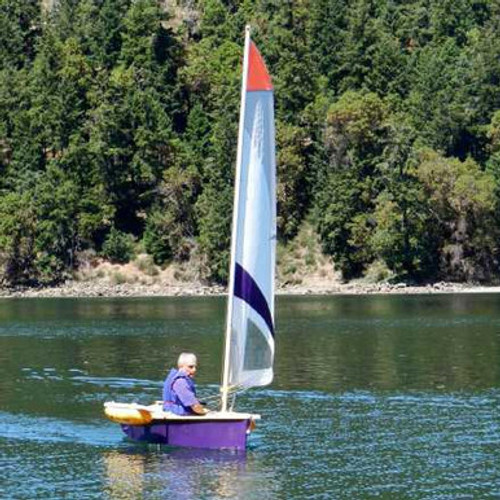"SUN DANCE" - A sporty little 17 ft. outboard cruiser with a beam of 6'. Designed for 25-30 HP outboard motor. Hull is wood, mahogany carvel planking. Designer calls her a "cruisemite". With this unique arrangement plan, sleeping is done under the spray-hood canopy, leaving the fore cabin for dry duffel, a practical setup. Plans include lines, offsets, construction drawings, arrangement plan, outboard profile, article reprint, etc. 3 sheets.
The basic function of any cruiser is to go places, and this technically excellent little cruismite is designed to do just that - she'll bulid from materials obtainable everywhere, and you can count on her to handle big water.
The following is from an article by Wes Farmer from Sports Afield Magazine
She is distilled out of an experience with outboard "cruisers" which stretches over the last a6 years. It was in April of 1928 that the plans for the first planing V-bottom outboard cruiser appeared in print. This boat was named Quadster. She was designed for the then new 18 hp four-cylinder Eito. A great many of these hulls were built. I had the good fortune to have designed her, and have designed a number of others since then.
Now, as I get into the business of planning the latest of this line of successful boats, I have again been involved in doping out a hull shape which will best fit the real usage to which such a craft is put. Again I come to the same basic conclusions about outboard cruisers. Out of this has evolved Sun Dance - an excellent bottom, a hull made a little better by a knowing arrangement plan, but basically embodying the same integrity toward wind, wave, rain and motor that has characterized the earlier hulls. They were all dandy boats.
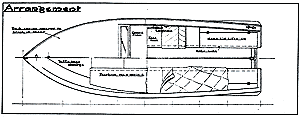
General arrangements - click to enlarge
Is an outboard "cruiser" a cruiser? No. Not if one attempts to crowd into a hull approximately 18 feet long the same creature comforts the 30- to 40- footers carry. A toilet takes room, real berths take room, a stove takes room, a fuel tank of decent cruising radius takes room. Sure - you can pack these things in. If you do, two things happen: one, the extensively extendable extensions of the trick arrangement always require that you unpack the toilet to get at the fuel lank so you can break out the anchor; second, weight piles up and the "go" in your boat evaporates.
If, as some designers do, you go out in beam to support all this weight, and go up in freeboard, you get a hull which wallows about at reduced speed in head seas, or at best acts like an inflated paper bag in any breeze.
Keep the boat and gear simple. As with the experienced traveler who moves with little more than a toothbrush, razor and change of socks, see to it that your outboard cruiser and her gear is simple. Then ' she will have some "git thar" in her. The basic fundamental of cruising is to go.
Mobility on land - trailerwise - is another factor you must consider. Given a crew of two or three, a stove for occasional hot eats, a gurry bucket for plumbing, two or three good berths to sleep on, and you can design a hull shape the cubic contents of which will be slim enough to cradle on the average trailer. Your bluff-bowed bathtub-ended hull with overhanging stem is a curse to transport.
The more you get to adding it up, the more you return to essentials. The first outboard cruiser designed by the writer was frankly stated to be functional as a canoe is functional: to carry a reasonable load on runs of short duration, to be able to take a beating if need be, but also to be able to scuttle for haven in time for bath and supper ashore, securely beached for the night. Sun Dance has these attributes.
Next come some considerations of cost, and the building factors. I have kept Sun Dance a raised decker. The current trend is toward the trunk cabin, or, as it turns out in some designs, a glass cabin with top. O.K. by me if you like 'em that way. Build some other boat than Sun Dance. She is raised deck for a number of reasons.
The first reason is that when I leap gracefully from the dock to the deck of my trusty ship I want to stay topside. I do not hanker to flap on through into the bilge with a load of glass and shattered shingles in my crotch.
The second reason is cost. The time-tried canvas-covered deck on Sun Dance builds easily and cheaply, whereas any honest builder will tell you that the glass-windowed trunk cabin will cost from a third to a half as much to build as the hull itself if done adequately. And add as much proportional time to building.
The third reason is dryness. No living man has yet made a cabin trunk that won't eventually leak, come spray and rain. Does one make the "cabin" of a boat this size a grand salon for social affairs? One does not. The best of cabins call for a shoehorn to help one enter; the function of the cabin is shelter, generally while asleep. Therefore since it is empty of humans 80 per cent of the time, and then is filled with humans generally prone in slumber, headroom is a delusion dearly paid for in performance. Comfortable ducking room is all we have in Sun Dance. We sleep in the cockpit under canvas shelter. But we do have a drum-tight dry place to stow gear where said gear will stay dry. If we want to anchor and sit out a rain, or if we have to run out a squall, up comes the spray hood and presto! - we have cover, sitting in the cockpit uprightly as the righteous should.
The seating arrangement or flying bridge or squatting department, what-you-may-call-it, has been swiped by me from an Ohio builder who built a Quadster. His boat had a 50 hp Cross four-cycle five-cylinder radial outboard. She fairly flew. This builder incorporated in his boat a semi-demi flying bridge with the protected seats forward. Riding up there was great fun. Dry, good vision, all the good qualities.
All this explains why Sun Dance looks as she does - that is, like a baby express cruiser. She has a stem that will be stiff. More, Sun Dance has forefoot; slow her down in a head chop, and her "legs" go down into the water, she slides through and is comfortable.
This estimable journal (Sports Afield) gets into a lot of the world's remote places. I have specified materials which can be obtained or substituted in Australia, Durban in South Africa, in Chile, or on the shores of Lake Superior. All these are places in which hulls of this type have been built and from the owners of which I have had letters.
Contradictorily, though the bottom of this boat cannot be planked with plywood in one hunk, her topsides can. It'll take two sheets of 3/8" exterior type plywood 2'-8" x 19' long, which means two special panels with 1'-4" x 19" wasted. Roughly 33 per cent waste. Hardly practical.
No, I think that for the good mechanic, which is the average Mr. American, the smaller the pieces of wood the easier your boat will build.
Now we have gone into Sun Dance's design at some length because I find that boat enthusiasts read to learn, and are not so much interested in being told how to hold a hammer or how actually to build a boat as they are interested in why a boat is as she is. It is this initial noodling stage that really decides a person to build a boat. The methods of building nearly always furnish themselves; so, later, we will give specifications of materials and fastening sizes, but first a word about the pure naval architecture of the hull.
In 30 years I have found nothing that is superior to a moderate beam-to-waterline-length ratio. We used to do boats that had a beam of .25 of length. Early, I began to use the
higher beams, and in utilities and runabouts designed for production boatshops. I have gone as high as .33â such boats wallow at lower speeds. So the optimum seems to be
a compromise, and Sun Dance has a B/L ratio of .28. The breast of a small hull which meets big water must be rather high and fine. On the planing surface it is best to keep the chine and keel and running lines parallel in elevation. This is now called "monohedron" bottom but is certainly nothing new. Five degrees of deadrise from keel to chine, or 3 inches in Sun Dance, is optimum. More deadrise results in a mushy beamwise feel to the craft when at rest. These facts are elucidated because current yelps of the semi-demi-cruiseola dopers are all for beam, beam, beam. It is a factor easily overdone.
This boat may be built in a number of ways, all of them good and all of them will produce an active, sharp little hooker that will become one of those treasured material things that comes along but rarely. You can build her seam-and-batten construction, for which specifications are given. Or you can plank the topsides with 3/8" plywood if you think you are man enough, and finish the bottom seam-and-batten.
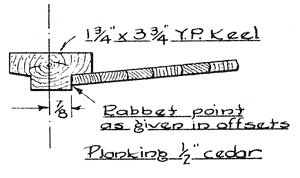
You can also build the little jobbie by the strip-construction method shown in section on the lines drawing (at right). Instead of using mahogany or white cedar planking in not over 6-inch widths as with seam-batten construction, you may get yourself a cutting head for making hollow-and-round strips, and plank up the whole hull out of red cedar, rift-sawn. In the latter case steam-bent frames 3/8" x 3/4" will have to be bent in from sheer to keel on 5" centers. This is no job to be afraid of; in fact, steaming is one of the best tools in any boatshop, and it would be well to visit a local yard to see how steaming is done. There is nothing to it except to get the wood hot. Even boiling it will do.
Exterior type plywood may also be sawed up to form planking in strakes, and these may be lap-straked with casein glue in the faying seams, clinched with 1-1/8" copper clout nails on about 1-1/2" centers. If mahogany or white cedar is used for planking, make it a full 3/8" thick. If red cedar is used, go to 1/2" thickness.
The main thing is to keep the weights about as shown in the specs, to use the framing and scantling sizes named, for they have been used and found adequate. Keep weights pared down to the bone. Don't go putting in a cast-iron range, electric refrigerator or any such gear. A boat is much like an airplane - you can't tamper with weights and be sure of getting the boat the designer was drawing when he made the plans.
An absolute must in building Sun Dance is to lay down the lines full sized and to fair them. This process means that the lines and body plan drawing are expanded to full size and that the heights of the chine and sheer and keel in elevation or profile match exactly those of the body plan. If you don't do this you'll get into serious and costly trouble. A fair boat goes together like cream cheese; an unfair one takes a master to pull out of the fat.
The lines must be faired. One does this to remove from the architect's drawings minor aberrations in scale which are unavoidable on small-scale drawings. Use a painted floor with a chalk line snapped for a base, or use building paper stretched to the floor with Scotch Tape for a laying down surface. A batten about 3/4 inch square, and 20 feet long, a straight edge and a framing square will be needed. From the body plan subtract the planking thickness, and you can then make your frames. These frames plus the keel and stem are erected bottom up on a strongback.
Most men building Sun Dance will have the necessary skill to do a creditable job once they know the scantling sizes. I have been especially careful to name fastening sizes either in the specs or on the plans, and good judgment will supply the size of bolts, screws or anything I may have missed. So let's have at the specs:
In General: Sun Dance to be 17 feet 3 inches long, 6 feet o inches beam, molded depth as shown on the lines plan. Power to be either 16 hp or 25 hp. Speed with 16 hp, '4-'7 miles per hour. Speed with 25 hp. 20-25 miles per hour. Standard shaft length motors to be used for construction shown.
Finish: Hull to be sanded outboard, primed with thinned priming paint applied warm from double boiler. Good drying time to be allowed for each coat to set up hard and bone-dry. Exterior of hull to be marine white. Interior of hull to be either varnished bright, or to be painted two coats of Copper Verde. Boot top to be red. Deck to be primed with putty thinned to creamy consistency with varnish, allowed to dry, and painted. Paint to be colonial buff with burnt sienna added, or a dark eye-saving blue. Coaming and bridge casing to be varnished bright.
Keel: Keel to be of oak, 1-3/4" x 3-3/4", or of fir same dimension. To be notched or gained into frames at proper laying levels for applicalion of planking. To be fastened to plywood floor members on frames with glue and screws, or glue and nails.
Stem: Stem to be of 1-3/4" oak, molded as shown. May be of hackmatack or apple knee if available, in which case one piece may be had. If stem is built up, glue the joints and fasten with 3/8" bronze hanger bolts such as are used for runabout struts. Counterbore bolt holes at stem face deeply and plug with same wood as stem. Rabbet stem to receive planking. For the amateur, this is usually best done as you go, first cutting in a light chisel line at the rabbet curve.
Frames: If of seam-batten construction, to be 5/8" x 3" oak, or 1" mahogany, spruce or equivalent. Glue and nail gussets (braces) in place. Subtract planking thickness from body plan. Notch frames after erection for seam battens.
Floors: May be of 1/4" fir plywood glued and nailed to frames, using three 1/4" galvanized bolts per half-side or six in all. Make proper allowance for keel height and notch in frames, also proper bevel for erection of these members in the gained notches.
Chine: Best construction calls for one piece white oak or mahogany chine in single length, rabbeted for planking. To be 1" x 2-1/4" in section as per sectional construction view. Optional chine material is yellow pine of slightly larger section. Counterbore for fastening from chine to frame. Use one No. 12 2-1/2" brass or bronze screw at each frame. Gain frame to hold chine. If inside or blind chine is desired, use much thicker soft wood such as cedar or soft mahogany which will swell, and use outboard spray knocker to finish off seam.
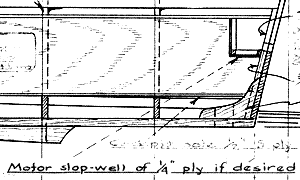
Transom: To be of 3/4" fir plywood, exterior type, if desired, but may also be of 1-1/4" hard Honduras mahogany feathered at the seam. Seam to be glued with casein glue. Cheekpieces of 3/4" x 3" white oak to be glued to transom edges and fastened with 1-1/4" No. 10 flat-headed brass screws on about 4" staggered centers. These cheekpieces take the main fastening strain. (See drawing at right) Transom to be cut down for motor to be used, allowing only opening just sufficient to swing motor from side to side. Don't guess on this - measure your motor. Keep side openings as small as possible to avoid stern wash coming aboard. A plywood slop well can be installed. See drawing.
Planking: Preferably of mahogany, to finish 3/8" thick, laid in strakes no wider than 5 inches at widest. Wider planks will buckle and will not fair. Planks to be spiled to fit run of seam battens. Planks to be fastened with 3/4" No. 8 flatheaded brass screws on 3" centers. Counterbore lightly and drive carefully to finish flush when sanded. Do not attempt to plug.
Alternate planking may be white cedar of clear stock, same dimensions and fastenings. Harden planking after sanding with shellac liberally thinned with alcohol before painting.
Alternate planking if of strip type construction: red cedar strips hollowed and rounded and edge nailed every four inches with 7 penny galvanized nails. This puts fastening job blind and is easy to do. Planking strips to be 1/2" x 1-1/4". Must have steam-bent frames 3/8" x 3/4" on 5" centers bent from sheer to keel and run over band-sawed fillet blocks at chine. Fasten planking to these frames with 1-1/4" copper clout nails on every other strake at each frame. Use 1-1/4" No. 8 flat-headed brass screws on alternate planks to main sawed frames.
Clamps: To be of any good clear close-grained wood sized as shown. Screw-fasten to frames with 1-1/2" No. 12 flat-headed brass screws. Berth Tops and Cockpit Flooring: Shown on sectional drawings. Boy Scout sleeping bag makes an excellent berth.
Deck Carlings: To be of white oak 3/4" x 2-1/4" sawn to proper crown. Decking to be t&g maple or fir to narrow widths, or cover with 1/4" plywood and then with 10-ounce canvas laid in marine glue. Fill canvas with creamy mixture of putty and varnish, or with patented seam composition.
Caulking: Light string caulking where needed, with seams and water edges filled only after hull is completely sanded with 900 Seam Sealer run in fillets along keel, chine edges, transom edges, etc. on inboard side. This is a rubberlike sealer which cures into rubber and stays flexible forever. Great stuff.
And this just about covers it, mates. From this, in addition to the plans, you can get a little cruiser that will withal be a fine hooker. She sure withal will be!
Weston Farmer
